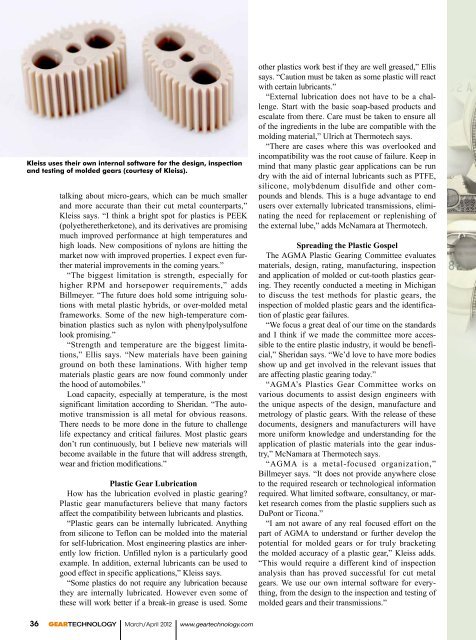Download PDF - Gear Technology magazine
Download PDF - Gear Technology magazine
Download PDF - Gear Technology magazine
Create successful ePaper yourself
Turn your PDF publications into a flip-book with our unique Google optimized e-Paper software.
Kleiss uses their own internal software for the design, inspection<br />
and testing of molded gears (courtesy of Kleiss).<br />
talking about micro-gears, which can be much smaller<br />
and more accurate than their cut metal counterparts,”<br />
Kleiss says. “I think a bright spot for plastics is PEEK<br />
(polyetheretherketone), and its derivatives are promising<br />
much improved performance at high temperatures and<br />
high loads. New compositions of nylons are hitting the<br />
market now with improved properties. I expect even further<br />
material improvements in the coming years.”<br />
“The biggest limitation is strength, especially for<br />
higher RPM and horsepower requirements,” adds<br />
Billmeyer. “The future does hold some intriguing solutions<br />
with metal plastic hybrids, or over-molded metal<br />
frameworks. Some of the new high-temperature combination<br />
plastics such as nylon with phenylpolysulfone<br />
look promising.”<br />
“Strength and temperature are the biggest limitations,”<br />
Ellis says. “New materials have been gaining<br />
ground on both these laminations. With higher temp<br />
materials plastic gears are now found commonly under<br />
the hood of automobiles.”<br />
Load capacity, especially at temperature, is the most<br />
significant limitation according to Sheridan. “The automotive<br />
transmission is all metal for obvious reasons.<br />
There needs to be more done in the future to challenge<br />
life expectancy and critical failures. Most plastic gears<br />
don’t run continuously, but I believe new materials will<br />
become available in the future that will address strength,<br />
wear and friction modifications.”<br />
Plastic <strong>Gear</strong> Lubrication<br />
How has the lubrication evolved in plastic gearing?<br />
Plastic gear manufacturers believe that many factors<br />
affect the compatibility between lubricants and plastics.<br />
“Plastic gears can be internally lubricated. Anything<br />
from silicone to Teflon can be molded into the material<br />
for self-lubrication. Most engineering plastics are inherently<br />
low friction. Unfilled nylon is a particularly good<br />
example. In addition, external lubricants can be used to<br />
good effect in specific applications,” Kleiss says.<br />
“Some plastics do not require any lubrication because<br />
they are internally lubricated. However even some of<br />
these will work better if a break-in grease is used. Some<br />
other plastics work best if they are well greased,” Ellis<br />
says. “Caution must be taken as some plastic will react<br />
with certain lubricants.”<br />
“External lubrication does not have to be a challenge.<br />
Start with the basic soap-based products and<br />
escalate from there. Care must be taken to ensure all<br />
of the ingredients in the lube are compatible with the<br />
molding material,” Ulrich at Thermotech says.<br />
“There are cases where this was overlooked and<br />
incompatibility was the root cause of failure. Keep in<br />
mind that many plastic gear applications can be run<br />
dry with the aid of internal lubricants such as PTFE,<br />
silicone, molybdenum disulfide and other compounds<br />
and blends. This is a huge advantage to end<br />
users over externally lubricated transmissions, eliminating<br />
the need for replacement or replenishing of<br />
the external lube,” adds McNamara at Thermotech.<br />
Spreading the Plastic Gospel<br />
The AGMA Plastic <strong>Gear</strong>ing Committee evaluates<br />
materials, design, rating, manufacturing, inspection<br />
and application of molded or cut-tooth plastics gearing.<br />
They recently conducted a meeting in Michigan<br />
to discuss the test methods for plastic gears, the<br />
inspection of molded plastic gears and the identification<br />
of plastic gear failures.<br />
“We focus a great deal of our time on the standards<br />
and I think if we made the committee more accessible<br />
to the entire plastic industry, it would be beneficial,”<br />
Sheridan says. “We’d love to have more bodies<br />
show up and get involved in the relevant issues that<br />
are affecting plastic gearing today.”<br />
“AGMA’s Plastics <strong>Gear</strong> Committee works on<br />
various documents to assist design engineers with<br />
the unique aspects of the design, manufacture and<br />
metrology of plastic gears. With the release of these<br />
documents, designers and manufacturers will have<br />
more uniform knowledge and understanding for the<br />
application of plastic materials into the gear industry,”<br />
McNamara at Thermotech says.<br />
“AGMA is a metal-focused organization,”<br />
Billmeyer says. “It does not provide anywhere close<br />
to the required research or technological information<br />
required. What limited software, consultancy, or market<br />
research comes from the plastic suppliers such as<br />
DuPont or Ticona.”<br />
“I am not aware of any real focused effort on the<br />
part of AGMA to understand or further develop the<br />
potential for molded gears or for truly bracketing<br />
the molded accuracy of a plastic gear,” Kleiss adds.<br />
“This would require a different kind of inspection<br />
analysis than has proved successful for cut metal<br />
gears. We use our own internal software for everything,<br />
from the design to the inspection and testing of<br />
molded gears and their transmissions.”<br />
36<br />
GEARTECHNOLOGY March/April 2012 www.geartechnology.com
















